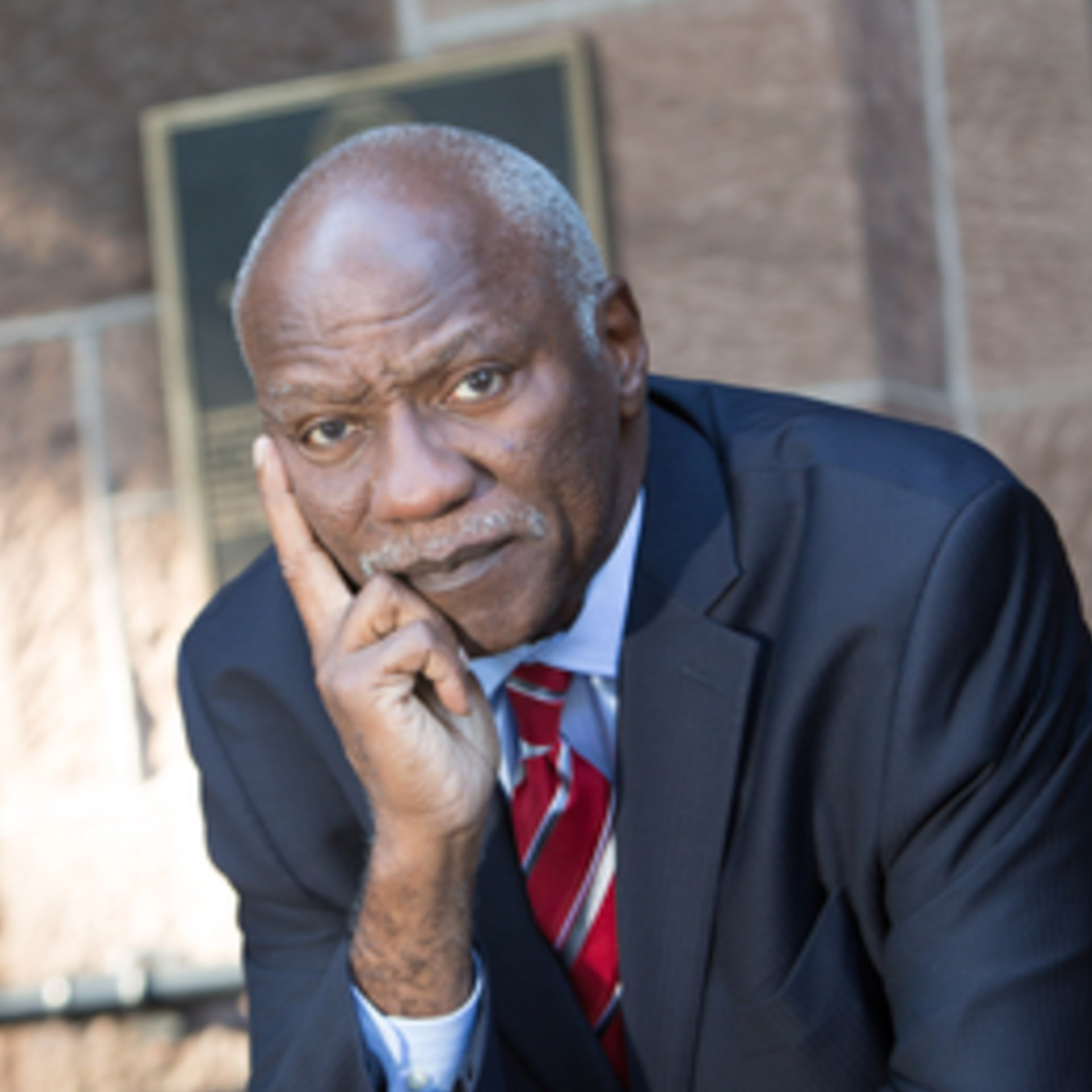On this insightful and timely episode of EJBTalks, Stuart Shapiro sits down with Professor Ron Quincy, policy and planning educator and advocate for diversity and inclusion. The two discuss how higher education, like all society, is at a crossroads with the issues of diversity, equity, and inclusion. Professor Quincy explains how academia philosophically is ahead of its time but compared to the private sector, can fall behind in actually incorporating a richer diverse culture and accountability structures. The two discuss Professor Quincy’s personal experience of social activism in the 1960s, how civil disobedience in the 60s–triggered by inequity and despair and ignited by police shootings–unfortunately mirror the current national issues, including the murder of George Floyd. The two discuss how we as a nation can move forward from police training and accountability to truly embracing a diverse society.
Stuart Shapiro
Welcome to EJB Talks. I’m Stuart Shapiro, the Associate Dean of the Faculty at the Bloustein School, and the purpose of this podcast is to highlight the work my colleagues and our alumni in the field of policy, planning, and health are doing to make the world, the country, and New Jersey a better place.
Today, we have Ron Quincy, a professor of practice who teaches courses on poverty and inequality, health disparities, community organizing, and a wide range of other things at the Bloustein School. Welcome to the podcast, Ron.
Ron Quincy
Well, thank you very much, Stuart, I’m very delighted to be here.
Stuart Shapiro
So as my intro indicated, you teach a lot of courses over a fairly wide range of subject materials for us. And you’ve also done a great deal of stuff over your career as I was looking through your CV there. Is there a theme that weaves its way through your experience in your courses?
Ron Quincy
Well, absolutely. First of all, we have phenomenal students at Rutgers University, both at the graduate and undergraduate levels. And so I try to keep up with the speed and the pace of the students and the scope of interest that they have. So we try to operationalize the course syllabi, so that they are both informative, but also interesting. So we try to use case examples, that helped to magnify the textbooks. And so as an example, with my global poverty class, I also teach global health, right? And the alignment between poverty and health is well known in the fields of public health and medicine.
I also teach managing people and organizations, and I teach community organizing. And so I find that these two courses have lots of common principles associated with them. And sometimes students, of course, take both of those graduate courses. But excitingly, I also teach in the School of Arts and Sciences, honors seminars for students at all stages in their academic careers. From first-years to seniors, for the Honors College, in SAS honors students and that’s a very terrific course as well, that helps to develop their leadership skills. And so as a result, I’m finding synergy between and among many of the courses that I teach.
Stuart Shapiro
Gotcha. Now I know, to sort of switch topics on you here, recently you’ve been working on diversity, equity, and inclusion at the Bloustein School. And I don’t want to talk about the Bloustein School in particular, because I know the work is ongoing. But I was just wondering if you could talk for a few minutes about the challenges around DEI issues for higher education generally.
Ron Quincy
Yes. So higher education, as a part of the general society, is at a crossroads with the issues of diversity and equity and inclusion and belonging. We are at a point where we are rethinking the means and the methods of creating a more diverse environment, as well as spending a great deal of time and effort thinking about how we make our institutions more welcoming to diverse populations. And you can’t have one without the other. You can’t aggressively recruit faculty of color and students of color and then not work equally hard to retain them. And retention is in large measure due to belonging. And carried in a sense of equity, within the higher education experience. Whether you’re a student, a staff member, or a faculty member, or a dean or president. If you talk to presidents of universities, they will tell you the same thing in terms, those who are women or people of color, how different it is for them as opposed to their colleagues. And how challenging it is.
Because on the one hand, there’s this need to present a progressive package of programming and an aggressive and progressive plan of action. But on the other hand, there’s the reality that higher education institutions do not change easily. And as a consequence, the challenge is long-term… it just been a long-term and consistently challenging effort to diversify and bring equity within our institution. So Rutgers, our President Holloway, launched his new tenure as our president, just prior to the pandemic. He launched his initiative around the theme of creating a beloved community at Rutgers.
And a beloved community is an aspirational philosophical framework. It is not a concept that you likely achieve. It’s a concept that if you work hard, and you make amazing progress, that that progress in and of itself creates an institutional framework that allows you to have equity and to have diversity. Because it is so aspirational, it is hard to articulate it to a broader base of students and faculty and staff, and alumni and donors. And so he’s doing a great job of trying to do that. But I believe that it is each individual’s responsibility among the 100,000 of us, students, faculty, staff, at Rutgers, it is on each of our part’s responsibility to seek that beloved community. Get as close to it as we possibly can. In the meantime, creating a more diverse and more engaging university community.
Stuart Shapiro
Gotcha. And that’s, of course, you know, and I agree with everything there. But it is a big ask, right? We’ve got 100,000 people here and to sort of inculcating that mindset into such a wide and yes, diverse group of people is no easy task. What are the sort of steps we need to take to try and get there?
Ron Quincy
Well, I think, number one is a consciousness-raising phase. And any social change movement, raising the consciousness of not only those who feel disaffected but those who also feel that they, while they have privilege, that that privilege might be infringed upon if you actually do achieve a beloved community. And so consciousness-raising, I think, is the number one thing, is the first thing that you have to do.
Secondly is accountability. And accountability at every level. We have this great debate on campuses, about free speech, and the ability for us to be able to have a dialogue, even contentious dialogue around a range of subjects. And part of a beloved community suggests that we need to have those free and open debates. Sometimes no matter how painful they may be, because if we don’t raise the consciousness levels, we cannot operationalize the beloved community in a diverse environment. So number one is consciousness-raising. The second thing is as we try to operationalize that putting in policies and practices that are perceived, and in reality are equitable. And so once again, you know, being able to have a philosophical conversation about a beloved community, but not have the policies and practices that relate to creating an equitable environment will negate your pathway toward a beloved community. So consciousness-raising and a focus on equity.
And then thirdly is belonging and making sure that we are culturally competent in our work, in our learning as students, in our work and our teaching as faculty, and in our work as administrative staff. We have to be very culturally competent. And a lot of this is going to require training, specialized training, group training, self-guided training, so that we, as an example, know how to …what the best practices are as relates to identifying with and working with students and faculty and staff who have physical or mental challenges or disabilities. That takes more than compassion, it takes knowledge and being competent, and how we engage in those.
The same thing on the issues of gender. You know, we’ve come a very long way, in higher education, and here at Rutgers, to creating greater opportunities for women faculty, at the tenure track in tenured levels. I believe the last data I saw on Rutgers women, junior faculty, at the assistant professor level, as an example, that women have reached parity. They are still differentiations, within certain departments, certain STEM departments, as an example. But if you add up across the university, women have reached parity, at least in terms of assistant professor level.
But as you move up the ranks to associate and full professor, and distinguished professor ranks, then males far outnumber our women faculty. So in the pipeline, there is the opportunity for greater success in the future with the younger faculty, women faculty, but currently, we still have those gaps at the more senior levels. So, having an operational strategy, that is long-term in vision, but is measured on an annualized basis, and where accountability structures are put in place for everyone along the continuum of recruiting, retaining, and promoting of faculty. Whether they’re women or faculty of color, and, of course, providing greater access to students of color, and particularly from historically disadvantaged backgrounds.
Stuart Shapiro
So I want to connect what we’re seeing in higher ed with the country. If you read, if you spend as much time on social media as I do, which is far too much frankly, you know higher ed has the reputation of “being woke,” or being especially obsessed with these issues that we’re talking about. And yet these challenges still very much exist. You and I, who live through it every day, know that. And if that’s going on for higher education, what does it say about where we are as a country as a whole in dealing with these kinds of issues?
Ron Quincy
Yeah, great question, Stuart. And I think this; that, while we have a history in higher education, of being more avant-garde on social and economic issues, in practice, in reality, our actual contributions to the greatest society has not measured up to the image of the ivory tower being more liberal and progressive. It is more liberal and progressive. But that’s more in philosophy in theory than it is in practice. And so you will find in a lot of blue-collar jobs, that their representation, their diversity is better than, let’s say, faculty positions. And you say, “Well, you know, this educational gap there,” right? And then what I’m saying is, that whether you’re looking at blue-collar jobs, government positions that are professional jobs, whether you’re looking at even in the corporate world, the private sector world, the diversity is oftentimes richer, where there are accountability structures for meeting goals than what we have in higher education.
So it is true. And I accept the premise that we are on large measure philosophically more progressive. But with regard to the actual results of creating more diversity, and more opportunities for growth and development, we have seen more success outside of higher education than we have within higher education. And that’s a problem throughout the country, it’s not limited to one region of the country. We’re getting better at it. But we still have great challenges there.
Stuart Shapiro
So the year we’ve been doing this podcast, we started right as the pandemic hit, in part as a response to it. You know, it’s trite, but still true to say it’s been a year unlike any other in the country, and certainly anything… I’m a little too young to remember the mid to late 1960s. But certainly, nothing in my lifetime has approached what we’ve seen in the past year. What about the past year, as we’ve gone through COVID, as we’ve gone through George Floyd and the protests, as we’ve gone through a political climate that has been insane, what has it shown to you about where we are on diversity, inclusion, race relations in the country as a whole?
Ron Quincy
Well, Stuart, our constitution proposes that we have great expectations as citizens. Our constitution proposes that, while in its beginning was an exclusive constitution, a very limiting constitution, excluding women, excluding people of color, such as the slave population, and the Native Tribal populations the indigenous populations and so many others who were excluded, excluded to the extent that we weren’t in our first census. We weren’t even counting these people, let alone giving them constitutional protections.
And what troubles me is that while we have made tremendous strides, and you mentioned the 1960s. I lived through the 1960s, the rebellions, the civil disobedience, the civil disorders that touched hundreds of cities across our country, including New Brunswick, the seat of Rutgers University. The New Brunswick campus, and Newark, and Camden, and then my home city of Detroit. The explosion in most of these cities was fundamentally triggered by a sense of inequity and despair and ignited by a police shooting. Virtually every single one where there was a crowd, disruptions, and civil disorders, they were triggered by police shootings. And I recall, President Johnson’s reaction to the civil disobedience in Newark and in Detroit in 1967. Newark occurred one month before Detroit’s and the response was a military one. The response was sending, in Detroit as an example, 5000 federal troops who were Vietnam-era war, active duty troops. I remember the tanks rolling down the streets shaking the photographs on my parents’ wall, one of Martin Luther King, Jr, one of President Kennedy, and one of Jesus on the wall.
The tanks, rattling the walls and shaking off these photographs, I remember those days. And I remember saying to myself as a teenager in high school, chairing the school’s committee on equal rights… I thought to myself, this can’t be the America that I was born into. President Johnson agreed. And he appointed as you know, what is called the Kerner Commission, which was more legally the President’s Commission on Civil Disorders. And he asked that commission, he charged it with three questions. One, “What happened”? Two, “Why did it happen”? And three, “What can we do to make sure it doesn’t happen again”? Those three questions.
And I was doing a forum on the 50th anniversary, I was a speaker and panelist during the 50th anniversary of the Kerner Commission Report in Detroit. And the last surviving member of the President’s Commission and I were speaking on the panel. And he made it clear to us all that as a young U.S. senator from Oklahoma, what he envisioned the answers to the President’s questions were going to be before the commission started his work. But to the surprise of the President, and many members of his commission, the results were quite different.
And the results, the conclusions were that we were moving towards two societies. One black, one white, separate and unequal. And further, that the so-called ghettos, the urban centers, where the vast majority of people of color were concentrated. And the Commissions’ conclusion was that the ghettos were created by white society, and institutional racism, they were maintained by them. And that it was society’s responsibility to correct the inequities that had created this rise of despair by communities across the country. So very briefly, if you look at the 12 indices that the Commission reported on, that was the basis for grievances of the communities. At the bottom of those 12 was welfare reform, which was a surprise of the president and his cabinet, but at the top was police misconduct, and police abuse.
And so over five and a half decades ago, when the President’s Commission, in its research found that police misconduct was the most recognized grievance of black and brown communities in this country. Here we are again with George Floyd, and Congress debating the George Floyd police, the new legislation to create better policing, and more equitable policing. It’s astonishing. Further Stuart, it doesn’t have to be that way. We don’t train our police in the same ways of using deadly force, as we train our military personnel. If you look at the U.S. Army’s military law and use of deadly force, the training that’s required for our military personnel in the use of deadly force, whether it’s in the war theater, involving civilians or outside of a war theater, the criteria are more stringent than they are for our local police domestically, here in the United States. The average is 58 hours of training for police in using guns and only eight hours of police training in de-escalating a situation.
In the military, the training on the use of weapons is ongoing. It’s rigid. It’s evaluated. And there is accountability for your inability or your unwillingness to use those weapons in a safe way and only use them and discharge them when they are absolutely necessary. They teach de-escalation, even when they are in the war theater. So we need to do more. And the George Floyd Act will help us with our police forces to use more. We need to diversify our police forces even better than we are now. A generation ago, there were residency rules for police and fire protectors and public school educators. We don’t have those, for the most part in our country anymore. So they’re viewed as an occupied force. And when you have an occupying force in any kind of human environment, whose cultural competency is inconsistent with the people that you are overseeing police, particularly in a policing environment, you’re going to have these problems.
And, they’re going to be systemic, and that’s what we’ve been seeing. So it’s disheartening. Stuart, many years ago, in another state and state of Michigan, I was on the governor’s criminal justice commission, and I was appointed the chair of the Subcommittee on Police Use of Deadly Force. And that was back in the 80s. The early 80s. And, our report mirrors the same reports that are coming out right now. More accountability, more training, more legal accountability for police use of deadly force. When that deadly force was not warranted.
Stuart Shapiro
It’s got to feel like deja vu.
Ron Quincy
Yes, it feels like deja vu all over again.
Stuart Shapiro
Yeah. So I urge our listeners, and Ron if you’d like to, as well. We did an early segment in the history of the podcast last year with Sandy Jaffe, who was on the Lilley Commission, which was the New Jersey version of the Kerner Commission, back in the late 60s. And his history, and in talking about that, and also, his sense of deja vu, I think, was also quite, acute in having lived through that. Ron, any sort of parting words, before we wrap up here that you’d like to give our audience?
Ron Quincy
Well, I could say, keep hope alive. I can say, let’s seek the new frontier. I can say let’s have a great society. I can echo presidents of the past who have wanted better for America and Americans, who have wanted us to be more inclusive to at least the theme of our preamble to our Constitution. And so those are my parting words that we are one nation and together we can meet these challenges of the 21st century.
Stuart Shapiro
Well, that’s a message I do like to end on. Ron, thank you so much for a really great conversation.
Ron Quincy
Thank you. Thank you very much, Stuart.
Stuart Shapiro
Also a big thanks to Amy Cobb and Karyn Olsen for the work they do to get this out every week. We’ll be back next week with another talk from another expert at the Bloustein School. Until then, stay safe.




